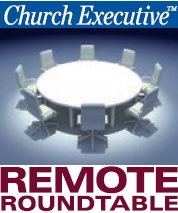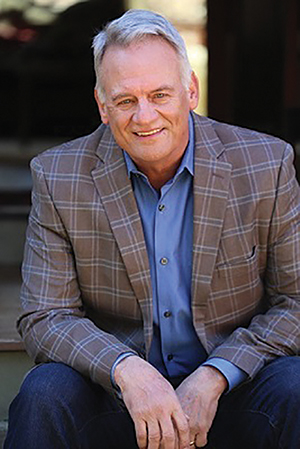
 Joel Mikell, Partner at Horizons Stewardship, and Doug Turner, President of Culture of Ready, answer your important follow-up questions to their Webinar, “Engaging and Discipling Your Church’s Financial Leaders,” now available at www.churchexecutive.com/webinars.
Joel Mikell, Partner at Horizons Stewardship, and Doug Turner, President of Culture of Ready, answer your important follow-up questions to their Webinar, “Engaging and Discipling Your Church’s Financial Leaders,” now available at www.churchexecutive.com/webinars.

Partner
Horizons Stewardship
What message would you suggest for helping Financial Leaders to know the life changes that their giving is empowering?
Joel Mikell: There’s something about the power of personal story and sharing it in real life, as opposed to reading about it. Reading and writing about it is good; but, someone explaining that their life has changed because of someone else’s generosity is one of the most powerful ways of helping connect dollars to people, and money to ministry impact.
Doug Turner: The storytelling element is the primary part of your message. The medium that you decide to use depends on your context. Not only do you want to talk about a life change for the person who received the benefit of ministry in their lives, you also need to tell the story of people who’ve had their lives changed by providing that generosity.
That kind of open, authentic transparency is huge, because people are always a little suspect. You need to highlight not only the outcome of ministry, but also the element of, ‘This is how God changed my life because of my generosity, my giving.’
What’s a good way to recognize Financial Leaders in a church? Behind my question is Jesus’ directive, Don’t let the right hand know what the left hand is doing, in regard to giving. Do you have any thoughts on talking to the congregation in the midst of a capital campaign about Financial Leaders and big gifts without making it seem like the big ones are all that matters?

President
Culture of Ready
Turner: We have to recognize that in that passage of scripture, when Jesus is teaching about giving and the attitude around giving, he’s teaching the same thing around prayer. The idea is simply this: We’ve never been upset with people praying in public; but when we talk about giving in public, we create a different standard.
I think Jesus is focused on an attitude around why you do what you do. Again, the life change story is important, and a church leader needs to be able to illustrate what it means to exercise generosity — I’ll even use the word ‘sacrifice.’ What does a sacrificial gift look like, and what does it mean?
The greatest example of generosity in the bible is the widow who gave her two small coins. It’s the smallest recorded gift, and the greatest example of generosity. How do we give that proportionate kind of direction on both ends? Because I think both sides of that narrative are very, very important.
Mikell: The key is making sure that when we talk about sacrifice, giving and generosity from a biblical perspective, that we include both ends of the giving spectrum — from the widow and the widow’s mite in Luke 21:1-4 and the “command those who are rich…” in I Timothy 6. Our stories need to speak to both ends and everything in between.
It’s easy to identify the major givers. How can we better identify those who have the capacity, but who aren’t where they should be, from a true tithing standpoint? In other words, how do I know that the person giving $5,000 a year isn’t capable of $10,000, or vice versa? How do I know the person giving $5,000 a year is or isn’t already giving above tithe?
“Not only do you want to talk about a life change for the person who received the benefit of ministry in their lives, you also need to tell the story of people who’ve had their lives changed by providing that generosity.”
— Doug Turner
Turner: If you have an intentional Financial Leader ministry, you’re having conversations and interacting around this. Some of your existing Financial Leaders will just know, frankly, who fits into those categories. This is where analytics help quite a bit; then, you make use of public information to get an approximation of what somebody might be able to give to a ministry.
Again, it has been used in institutional fundraising for a long time, and it’s a standard practice there. I recognize that there are more concerns about it in the local church, but I believe you can use this information discreetly and tactfully.
Should personal asks to primary givers typically come from pastors, or lay leaders?

Mikell: Typically, it should come from the senior minister / senior pastor. That’s usually the person within whom the vision and the flame burns the brightest and who Financial Leaders are looking to for that conversation.
Doug and I are both aware that in some settings there might be some hurdles and obstacles to overcome for that to take place. But, when we coach and counsel, our starting point is that the senior minister is the one who makes that ask, where an ask is involved.
Turner: Peer-to-peer interaction comes into play some; but again, it’s a contextual thing, and it’s a training issue, usually, that determines if the pastor is the person to do that. Normally, the person with the greatest passion for the vision is the most appropriate person to ask.
Are there ways to affirm and thank givers without causing them to feel self-conscious?
Mikell: One of the ways is to simply reach out to them and thank them for their full investment in the ministry. This should happen not just when they make a financial investment, but also as an expression of gratitude for their engagement and investment regarding other ministries in the church. That way, they’re not just hearing from you when it’s related to finances. We need to be good at saying thank you for everything that people are doing.
“[S]omeone sharing that their life has been changed because of someone else’s generosity is one of the most powerful ways of helping givers connect dollars to people, and money to ministry impact.”
— Joel Mikell
Who do you recommend for data?
Mikell: We highly recommend our analytics partner, MortarStone. The MortarStone platform allows the local church to quickly develop a holistic picture of your church’s givers based on their giving history, demographics, and other real-world habits. MortarStone has helped more than 1,000 churches track more than $10 billion dollars in giving from millions of givers.
How does planned / legacy giving fit into all of this?
Mikell: A planned / legacy giving strategy is certainly a component to consider within a ministry to Financial Leaders. With the anticipated wealth transfer of $30 trillion to take place over the next 30 to 40 years, the church might miss a great opportunity for significant ministry if it doesn’t have a planned giving strategy in place.
How much should church leadership know about people’s giving habits?
Mikell: At Horizons, we believe that the pastor(s) should be involved in the financial matters of the church, including knowledge of who gives and what they give. There is a FREE download of Dr. J. Clif Christopher’s (Horizons’ Founder and President) Rich Church/Poor Church, Chapter 8 on our homepage that addresses this subject in detail. For further compelling discussion on this topic, please see Not Your Parents’ Offering Plate (pages 18-22) also by Dr. J. Clif Christopher.
What about multisite churches?
Turner: Campaigns become a wonderful platform for generosity in a multisite context. Few things in a church will bring continuity around vision and mission like a campaign. It will help the multisite church bring an emphasis on the “one church” in the “one church, many locations” approach.
Campaigns — whether a church is one site or multisite — highlight “the power of one” in a church. They’re one of the few things a church does that pulls everyone together at one time, for one purpose, one vision, at one moment in time for one shared future. So, when many churches battle a silo approach to ministry with people defining church by the ministry silo they live in (example: when children’s ministry is someone’s focus, so he or she defines church primarily as children’s ministry), campaigns create a wonderful platform to define ‘church’ as the wider identity of vision and mission.
Remember, Financial Leaders will often surface through projects. In a multisite church, a churchwide project can unite Financial Leaders to a wider, bolder vision.
Also, analytics are even more valuable in multisite. Since most networking is done through relationships, the fragmented nature of multisite makes relational networking more difficult, if not practically impossible. Analytics will help you identify potential Financial Leaders who otherwise would go unnoticed.
My church has a $500,000 annual budget with 200 giving units, and 100 of those are giving less than $10 a week. Very few of the top givers tithe. So, we have a way to mature in our giving.
My questions are: What’s the best way to mature and grow conservative, Guardian-type givers? and What’s the best resource for change?
Comparing your discussions to our church’s classical annual stewardship program, it would appear we talk / teach the right biblical messages, but we lack a personal relationship to speak about giving at a personal, one-on-one level. A general ask and confidential response / giving always seems to come up a little short.
Turner: You need to look in to the motivations of Guardian givers, including seeing and understanding what and how you will accomplish results in ministry. In other words, know your process. If the Guardian has Financial Leader capacity, ask for his or her help developing the process.
Remember, most Financial Leaders are good problem-solvers. Entrepreneurs will help you create abstract opportunities; Guardians will help you get there. Both groups in Financial Leader categories tend to be problem-solvers. You build ownership when you speak into his or her gifts, and this is a critical step to financial investment.
Get your arms around data to help you develop strategies. Determine how many Financial Leaders you really have and how many potential Financial Leaders are really engaged. Develop a process for identifying Financial Leaders — for example, through analyzing annual giving, and by using data analytics to get a better sense for Financial Leader capacity. Remember that many of your potential Financial Leaders will not show up on annual giving.
Cultivate and develop a deeper relationship to understand how each Financial Leader processes generosity. You can do this by telling them your ministry story — pull back the curtain to see real impact. Develop a strategy surrounding the “ask,” to create conversational opportunities and ask for support. Always follow up and continue to answer questions. Show gratitude by thanking givers for the support. Show them what their investment has accomplished by way of transformational life change.
— Reporting by Joyce Guzowski


